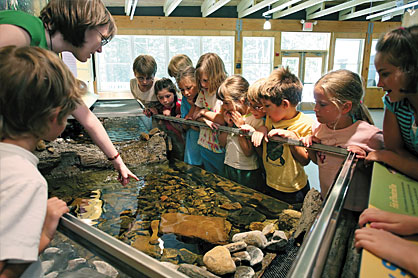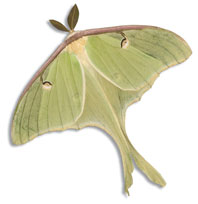|
“Everyone talks about sustainability, but people need to see it and they need to understand what’s at stake.”
Linda Farley, chair of the division of education for Carnegie Museum of Natural History
|
 |
Branching Out
No longer just a research haven and pretty walk in the woods, Powdermill Nature Reserve is positioned as a leader in conservation and sustainability education.
No longer just a research haven and pretty walk in the woods, Powdermill Nature Reserve is positioned as a leader in conservation and sustainability education.
By Julie Hannon

Powdermill's Living Stream exhibit, stocked with a variety of trout and other freshwater
critters, is one of the many highlights of the expanded nature center. photo: Mindy McNaugher
Throughout the summer, Powdermill Nature Reserve is practicing a kind of bait-and-hook strategy for luring in—and winning over—newcomers to the research oasis tucked away in the rolling hills of the Laurel Highlands.
On the weekends, staff naturalists are leading free outings on the reserve’s 2,200 acres of sprawling woodlands, streams, open fields, and ponds, including outdoor adventures for children, bird watching tours, fitness hikes, wildflower walks, and butterfly gardening. And that’s just for starters.
While the reserve has been Carnegie Museum of Natural History’s biological research station since 1956 and is just 60 miles from Pittsburgh, most museum members have never visited, and they don’t know what they’re missing. For years this was at least partially by design, in part for research purposes, but also due to limited resources and space for public programming, which traditionally focused on school groups and summer camps and served mostly those in and around the Ligonier Valley.
But that’s changing. While best known for its world-class bird-banding program, Powdermill’s newly expanded and renovated nature center is allowing it to spread its wings as a leader in conservation and sustainability education. One of Powdermill’s new programs, family overnighters, is a one-of-kind adventure that includes bird banding, live-trapping of small mammals, a campfire barbecue, and nighttime
exploration. Other new activities include a slate of natural history courses for adults, a field academy for high schoolers, and a variety of artist workshops.
“Our aim is to give visitors a transformative experience,” says Linda Farley, Powdermill’s new director of educational technology and environmental education and chair of the division of education for Carnegie Museum of Natural History. “We could always do that with our forests and streams, to invite visits to experience and appreciate nature, but the new building offers a truly unique learning opportunity.”
The $5 million green expansion, completed a year and a half ago, added 10,000 square feet of space that, by design, is the perfect case study in environmentally sensitive construction. The barn-like structure truly has a calming effect; it’s clean, open, and filled with natural light. And a self-guided tour walks visitors through its many green features.
Among them: strawbale insulation made from switch grass grown less than 20 miles away; interior wall boards made from recycled paper; a plant-based flooring; carpet made from recycled nylon and truck and bus tires; and, perhaps most impressive, a marsh machine that serves as an ecological wastewater treatment system, using plants to purify and recycle wastewater for clean flushes in nearby restrooms. Its Living Stream exhibit is fed entirely by recycled water and houses rainbow, brown, and brook trout as well as other freshwater critters, demonstrating the purity of the water produced by the marsh machine. The sound of it, akin to a bubbling brook, adds to the center’s calming effect.
“The main point of the new building was to have more space,” explains Joe Stavish, senior environmental educator. “We desperately needed it. But we didn’t just build more room; the building itself is an exhibit. You don’t just walk through it, you experience it.” This month, a dozen high school students will do just that, spending 10 days in residence at Powdermill as part of the first in what Farley hopes will be a series of field academies. The program is designed to hone environmental leadership skills, focusing on topics as diverse as sustainable agriculture, biodiversity, and global warming.
Guided by Powdermill educators, area university professors, and even Carnegie Museum of Natural History scientists, students will explore Powdermill as well as a variety of career paths. Once they’re back home in their communities, they’ll use what they’ve learned to complete an environmental science service-learning project.
“Everyone talks about sustainability, but people need to see it and they need to understand what’s at stake,” says Farley, an experienced conservation advocate and environmental educator. “We’re uniquely poised to do that at Powdermill. So, instead of giving people lectures and a lot of literature, we want them to experience it.
“That’s the whole challenge for sustainability issues. Yes, there is a need to understand its importance. But the next step is to get people to actually do it.”
 Farley and Stavish feel certain that once a broader audience—including college students, a more diverse group of researchers, and, of course, more museum members—set foot in Powdermill, they’ll fall for it hook, line, and sinker. After all, notes Stavish, there’s something magical in the water of Powdermill Run, the mountain spring that traverses the reserve’s forest. Farley and Stavish feel certain that once a broader audience—including college students, a more diverse group of researchers, and, of course, more museum members—set foot in Powdermill, they’ll fall for it hook, line, and sinker. After all, notes Stavish, there’s something magical in the water of Powdermill Run, the mountain spring that traverses the reserve’s forest.
“Kids, for instance, get into the water and collect. But it’s not just to collect,” he notes. “When they find a really interesting creature, I don’t tell them what it is. They need to investigate for themselves. I give them field guides and collection manuals and help them figure it out. It’s that exercise that helps them really make a connection. Especially if it’s a kid’s first visit, they’ll remember it forever.”
|
 Summer 2009
Summer 2009


 Farley and Stavish feel certain that once a broader audience—including college students, a more diverse group of researchers, and, of course, more museum members—set foot in Powdermill, they’ll fall for it hook, line, and sinker. After all, notes Stavish, there’s something magical in the water of Powdermill Run, the mountain spring that traverses the reserve’s forest.
Farley and Stavish feel certain that once a broader audience—including college students, a more diverse group of researchers, and, of course, more museum members—set foot in Powdermill, they’ll fall for it hook, line, and sinker. After all, notes Stavish, there’s something magical in the water of Powdermill Run, the mountain spring that traverses the reserve’s forest.